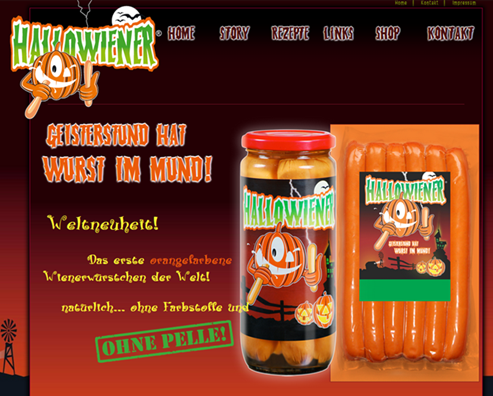Event mark: Deletion due to non-use – HALLOWIENER
The case: At Halloween, the spirits of the dead are said to return to their homes. Wiener sausages, presented in particularly spooky packaging, are one of many products that can be seen in the shops at this time of year. The company Selmikeit & Giczella went down this route: they developed dedicated packaging for Wiener sausages and invented a specific European event mark associated with Halloween:
HALLOWIENER
In addition, a special domain www.hallowiener.de was registered for the product. On the webpage, the product was advertised as follows:

When, in the course of a dispute, a competitor requested revocation of the trademark on the grounds of insufficient use during the previous five years, Selmikeit & Giczella submitted to the EUIPO evidence-of-use documents that showed a relatively low turnover in relation to this product. However, the company pointed out that an event mark can only ever be used during certain periods of time, which must be taken into account when assessing the extent of use. Since Halloween occurs on 31 October, sales could only take place in the months of September to November in any given year.
However, the documents provided were not sufficient, from an overall perspective, to preserve the HALLOWIENER trademark, and the event mark was cancelled.
Why?
The use of a trademark must be genuine, and this is not judged by way of an assessment of commercial success or a review of a company’s business strategy. Nor is trademark protection a tool to enable extensive commercial exploitation of trademarks.
Nevertheless, the use of a trademark must prove its actual commercial exploitation. This concerns in particular uses that are considered justified in the relevant economic sector in order to maintain or gain market share for the goods or services protected by the trademark. Uninterrupted use is not required for this. However, where an application for cancellation has been made, in terms of timescales, genuine use – albeit not necessarily continuous – of the trademark must be proven for the five-year period preceding the filing of the application, if the brand was subject to the use requirement in this period.
Documents and evidence must be submitted to prove genuine use, such as packaging, labels, price lists, catalogues, invoices, photographs, newspaper advertisements and written statements. These documents must relate to the territory of protection of the mark, the relevant five-year period, and the extent and the nature of the use of the mark.
Taking this as a basis, the inevitable result in this case becomes clear:
The domain name hallowiener.de did not prove that any sales by Selmikeit & Giczella had taken place. Nor did the website contain any information on prices or any facility to order the product online.
For the first relevant year of use, the company did indeed submit an advertising brochure, from the supermarket REWE, offering the sausages for €1.79. However, there was no information as to whether and to what extent the brochure was actually given to customers.
In addition to the brochure, a turnover of approximately €40,000 through a supermarket was proven for the first year. However, there was no proof of turnover for the four subsequent years. During this time, Wiener sausages were sold under the EU trademark via the company of the parents of the trademark proprietor’s managing directorr. There was no separate record of the turnover attributable to the products associated with this trademark.
In view of the fact that Wiener sausages are relatively inexpensive mass-produced articles, this proven turnover of €40,000 was not sufficient, in comparison to the mass market of sausages, to maintain or gain a market share for the brand in this market.
The fact that the brand was an event brand did not assist Selmikeit & Giczella. In the case of an event mark, it is acknowledged that sales can only take place on a seasonal basis. Even taking this into account, lower requirements in terms of the required scope of use of the trademark are not justified. Selmikeit & Giczella would at least have had to provide evidence of genuine use in the months of September to November for each relevant year.
General Court of the European Union, 10 November 2021, T-500/20
Learnings: Do not assume that the use of a trademark for a mass-distributed product will be subject to lesser requirements than other products, just because a certain kind of marketing makes it a seasonal item. In order to keep and defend a trademark in the long run, you should be able to prove genuine use of that trademark. To do this, you should continuously archive, in your company, any packaging, labels, price lists, catalogues, invoices, photographs and newspaper advertisements that are dated or that allow a chronological classification. You should also be able to call up the chronological turnover generated by the branded products at any time in your company records, ideally by means of electronic data processing. Evidence must be provided of actual commercial exploitation of a nature that is considered justified in the relevant economic sector in order to maintain or gain market share for the goods or services protected by the trademark.